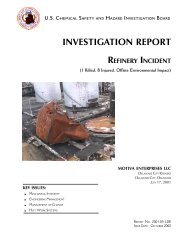CTA Report, Draft 1, ISP Review - US Chemical Safety and Hazard ...
CTA Report, Draft 1, ISP Review - US Chemical Safety and Hazard ...
CTA Report, Draft 1, ISP Review - US Chemical Safety and Hazard ...
Create successful ePaper yourself
Turn your PDF publications into a flip-book with our unique Google optimized e-Paper software.
Table 1<br />
Particle Size of Common Materials<br />
Common Material Size (microns)<br />
Table salt 100<br />
White granulated sugar 450–600<br />
S<strong>and</strong> 50+<br />
Talcum (baby) powder 10<br />
Mold spores 10–30<br />
Human hair 40–300<br />
Flour 1–100<br />
Source: Filtercorp International Ltd.<br />
6.4 Secondary Dust Explosions<br />
Typically, dust explosions occur when a small primary explosion—not necessarily a dust explosion<br />
itself—lifts dust deposits from floors, walls, overhead beams, or equipment. As illustrated in Figure 12,<br />
the suspended dust is then ignited, causing a secondary dust explosion. The blast wave from the<br />
secondary explosion causes accumulated dust in other areas to become suspended in air. This effect, in<br />
turn, may generate additional dust explosions. Depending on the extent of the dust deposits, a weak<br />
primary explosion may cause very powerful secondary dust explosions. At <strong>CTA</strong>, the initial explosion<br />
occurred at line 405, but secondary dust explosions caused severe destruction as far as 300 feet away,<br />
near line 401.<br />
48









